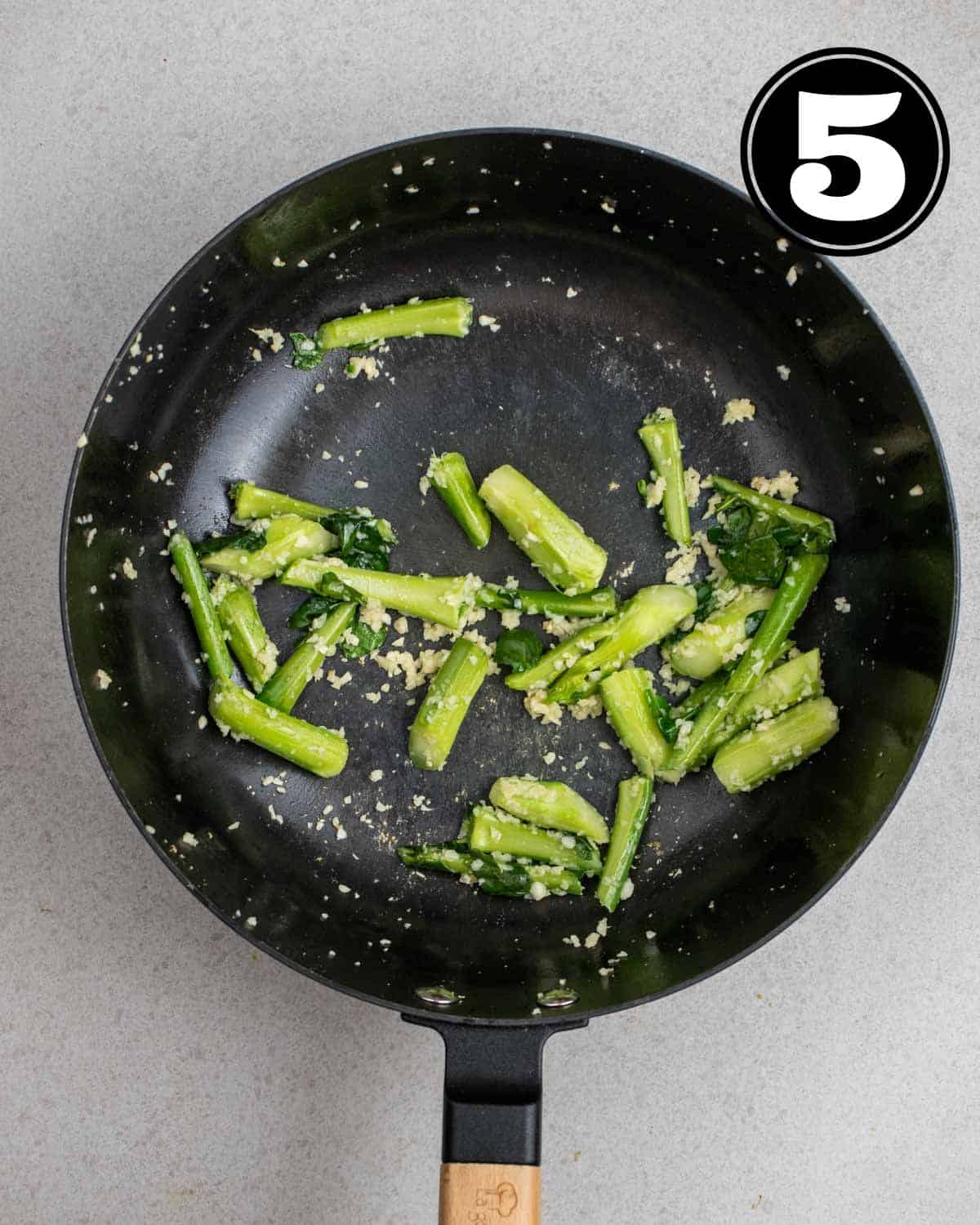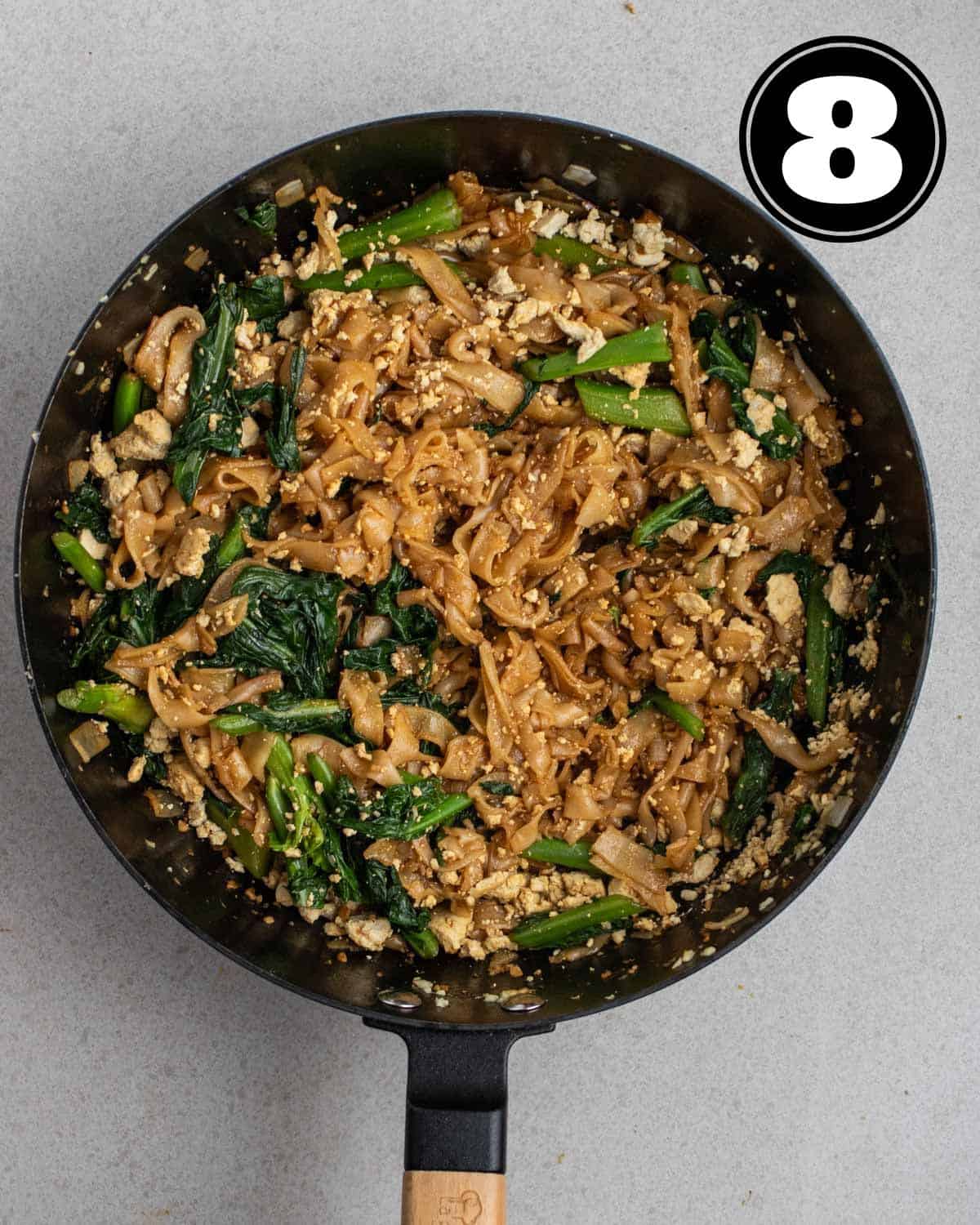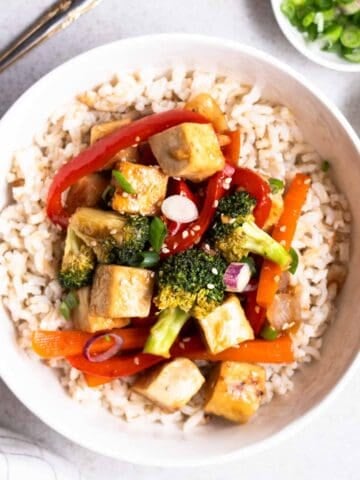This vegan pad sees ew is a delicious Thai dish that features lightly charred noodles, tofu scramble, and vegetables tossed in an umami and flavorful sauce. You can easily recreate this popular recipe at home with just a few simple ingredients and 30 minutes!

Pad see ew is one of my favorite takeout-style noodle dishes to make, and it is constantly on my weekly rotation of meals, along with my tofu pad Thai and vegan Japchae!
Whenever I feel like having a Thai-inspired feast, I pair this tofu pad see ew with my vegan Pad Krapow, Thai vegetable curry, tofu tom kha, and fresh spring rolls.
Jump to:
💚Why you will love this recipe
- Incredibly flavorful and jam-packed with flavors
- A quick and easy dish that is ready in 30 minutes
- Naturally spice-free, making them kid-friendly
- Super versatile and goes well with any Asian side or main dishes
🤔What is pad see ew
Pad See Ew is a well-loved Thai dish widely available in Thailand and internationally. It mainly consists of wide rice noodles (sen yai), eggs, meat (such as chicken or beef), and Chinese broccoli. The ingredients are fried with a rich, savory sauce made primarily of soy sauce, dark soy sauce, oyster sauce, and sugar.
This dish is savory and sweet, with a mild charred taste from the caramelizing the noodles (also known as 'wok hei'). Pad see ew is also a rare Thai dish that is not spicy, making it kid-friendly and great for those with low spice tolerance.
To make this recipe vegan, we will use tofu scramble instead of eggs. Additionally, vegetarian oyster sauce was used instead.
🍜What you will need


📃Ingredients notes and substitutions
- Tofu - Use firm or extra firm tofu. You do not need to press it beforehand.
- Noodles - This recipe traditionally requires sen yai or ho fun noodles, which are fresh wide rice noodles only available in Asian grocery stores. However, these noodles can be difficult to find outside of Asia. As an alternative, precooked dried pad Thai noodles can be used instead.
- Chinese broccoli (gai lan) - A common Chinese green that is leafy with tender stems. You can substitute it with broccolini.
- Oyster sauce - Opt for a vegan oyster sauce to keep this recipe vegan. I highly recommend using Lee Kum Kee’s stir-fry sauce. (Although it is labeled as a stir-fry sauce, it is a mushroom-flavored sauce imitating oyster sauce)
- Soy sauce - Use Thai soy sauce for the most authentic taste, but regular Chinese soy sauce will also work.
- Dark soy sauce - Thai dark soy sauce works best, but feel free to use Chinese dark soy sauce in place!
🔪How to make

Make the stir-fry sauce by combining dark and regular soy sauce, oyster sauce, and sugar.

Crumble up your tofu, then add nutritional yeast and salt. Stir to mix.

Heat ½ tablespoon of oil in a cast iron wok, and add tofu. Cook for 2-3 minutes or until they are hot. Remove from pan and set aside.

Add another ½ tablespoon of oil to the wok. Once the oil is heated, add garlic and fry for a minute.

Next, add the stems of Chinese broccoli, and cook for 2-3 minutes.

Then, add Chinese broccoli leaves, and cook until they are wilted.

Raise the heat to high, then add noodles along with stir-fry sauce. Toss until the noodles are well coated. Then, spread noodles around the wok and leave them for 10-15 seconds without tossing. Repeat this 2-3 times, or until noodles are slightly charred.

Remove from heat, and stir in scrambled tofu. Give it a taste, adding more soy sauce if needed. Your vegan pad see ew is ready to be served!
✔Helpful tips
- Separating clumps of fresh noodles - If using refrigerated fresh noodles, separate the strands by submerging them in warm water and gently breaking the clumps with chopsticks.
- Using a large wok - Ensures even heat distribution and that ingredients are evenly cooked. Alternatively, use a large non-stick skillet.
- Do not overcook noodles - If using dry noodles, ensure they retain a slight bite after cooking. Overcooked noodles tend to clump together and turn mushy in stir-fries.
- Preventing noodles from breaking - Avoid aggressively stirring noodles. Instead, lightly flip and toss them. Also, avoid stir-frying your noodles too long, or it might yield mushy and broken noodles.
- Storing leftovers - This vegan pad see ew dish is best enjoyed immediately after cooking. If you have leftovers, store them in an airtight container and refrigerate for up to three days. To reheat, you can use a skillet on the stove or microwave and add a splash of noodles or soy sauce to loosen the noodles if needed.
Save this recipe!
Also get a FREE high-protein vegan recipe eBook + weekly new recipes! Unsubscribe anytime.
✨Variations and add-ins
Veggies - Feel free to add other vegetables to this recipe, such as bean sprouts, bell peppers, carrots, baby corn, and button mushrooms.
Tofu - Can be substituted with pan-fried tempeh, chunks of seitan chicken or egg alternatives like JustEgg.
Noodles - Try using rice vermicelli instead of flat rice noodles for a different texture and mouthfeel.
Make it spicy - Add some dried chilies or chopped Thai chilies and fry it with the garlic. Or, you can drizzle on some sriracha or top it off with chili flakes before serving.
Seasonings - Adjust the amount of seasonings to your liking. I recommend tasting before serving and add more seasoning as needed. You can also try using vegan fish sauce or hoisin sauce.

❔Commonly asked questions
Pad see ew is typically not spicy, making it a great choice for kids and those with a low spice tolerance. If you love heat, you can make this recipe spicy by adding a generous amount of sambal oelek or frying some chopped chilies with the garlic.
Although rice noodles are used in this recipe, pad see ew is typically not gluten-free due to the use of gluten-containing condiments such as soy sauce and oyster sauce.
However, you can modify this recipe to make it gluten-free by using gluten-free soy sauce and oyster sauce.
Although both pad see ew and pad Thai are noodle dishes that originate from Thai, they are 2 different recipes with distinct textures and flavor profiles.
Although both pad see ew and pad Thai use rice-based noodles, the noodles used in pad see ew (known as sen yai) are much wider when compared to pad Thai noodles. Pad see ew is savory and umami, while pad Thai has a balance of sweet, savory, tangy, and spicy flavors. The complex flavors of pad Thai can be attributed to the various seasonings used, such as fish sauce, tamarind paste, sugar, and soy sauce.
📖 Recipe

Vegan Pad See Ew (with tofu)
Equipment
- cast iron wok or a large skillet
Ingredients
For noodles
- 16 oz fresh rice noodles or 7 oz dried*
- 4-6 stalks Chinese broccoli or broccolini
- 3 cloves garlic minced
For the sauce
- 1 ½ tablespoons vegetarian oyster sauce
- 1 ½ tablespoons soy sauce or tamari
- 2 teaspoons dark soy sauce
- 1 teaspoon coconut sugar (or any other granulated sweetener)
For scrambled tofu
- 7 oz extra firm tofu or firm tofu (about ½ block)
- 1 tablespoon nutritional yeast
- ½ teaspoon onion powder
- ½ teaspoon garlic powder
- pinch of black salt or regular salt
Instructions
Preparing noodles
- Fresh noodles - separate the strands before using them. You can easily do so by submerging the noodles in warm water and gently loosening them using a fork or a pair of chopsticks.Dried noodles - cook them according to the instructions on the package. Drain and rinse them under cold water, and set aside for later use.16 oz fresh rice noodles
Cutting Chinese broccoli
- Cut Chinese broccoli into 2 inches pieces, separating stems from leaves.4-6 stalks Chinese broccoli
Making pad see ew
- Make the stir-fry sauce by combining all ingredients needed.1 ½ tablespoons vegetarian oyster sauce, 1 ½ tablespoons soy sauce, 2 teaspoons dark soy sauce, 1 teaspoon coconut sugar
- Crumble up your tofu either using your hands or a fork, then add nutritional yeast, onion powder, garlic powder, and salt. Stir to mix.7 oz extra firm tofu, 1 tablespoon nutritional yeast, ½ teaspoon onion powder, ½ teaspoon garlic powder, pinch of black salt
- Heat up ½ tablespoon of oil in a cast iron wok over medium-high heat and add tofu. Cook for 2-3 minutes, or until they are hot. Remove from pan and set aside.
- Add another ½ tablespoon of oil to the wok. Once oil is heated, add garlic and fry for a minute. Next, add the stems of Chinese broccoli, and cook for 2-3 minutes.3 cloves garlic
- Then, add the leaves of Chinese broccoli, and cook until they are wilted.
- Raise the heat to high, then add noodles along with stir-fry sauce. Toss until the noodles are well coated.
- Optional: To create charred noodles, spread noodles around the wok, and leave them for 10-15 seconds without tossing them. Repeat this 2-3 times until the noodles are slightly caramelized and charred.
- Remove from heat, and stir in scrambled tofu. Give it a taste, addingmore soy sauce if needed. Your vegan pad see ew is ready to be served!
Notes
- Separating clumps of fresh noodles - If using refrigerated fresh noodles, separate the strands by submerging them in warm water and gently breaking the clumps with chopsticks.
- Using a large wok - ensures even heat distribution and that ingredients are evenly cooked. Alternatively, use a large non-stick skillet.
- Do not overcook noodles - If using dry noodles, ensure they still retain a slight bite after cooking. Overcooked noodles tend to clump together and turn mushy in stir-fries.
- Preventing noodles from breaking - Avoid aggressively stirring noodles. Instead, lightly flip and toss them. Also, avoid stir-frying your noodles too long, or it might yield mushy and broken noodles.
Save this recipe!
Also get a FREE high-protein vegan recipe eBook + weekly new recipes! Unsubscribe anytime.
Nutrition
Nutrition info calculated is just a rough estimate and is provided as a courtesy. Bear in mind that value will vary based on variables like specific brand or type of product used. To obtain the most accurate representation, it is highly recommended that you calculate it on your own with the actual amount and type of ingredient used.









CAROL says
1524mg sodium per serving!! YIKES. That's more than 3 times my allotment per meal! How would you suggest getting that down to 450mg sodium per serving?
Meesha says
You can use low sodium soy sauce in place of regular soy sauce. And a reminder that the nutritional info is just a rough estimate.😊
M says
And why would you add salt to the recipe? Use less soy sauce and skip the salt.